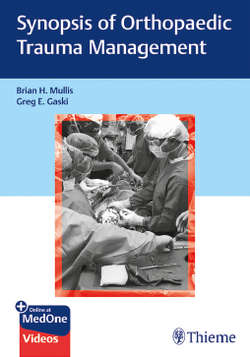Читать книгу Synopsis of Orthopaedic Trauma Management - Brian H. Mullis - Страница 89
На сайте Литреса книга снята с продажи.
II. Staging and Biopsy
ОглавлениеA. Full staging studies are ideally obtained prior to any surgical interventions including biopsies.
1. Radiographs in orthogonal planes of the entire bone to ensure there are no additional lesions.
2. Localized advanced imaging, such as magnetic resonance imaging or computed tomography (CT), is sometimes helpful for characterization of the lesion, endosteal extent, or soft tissue extension.
3. CT chest, abdomen, and pelvis to assess the most common sources of osseous metastases (lung, breast, thyroid, renal, prostate).
4. Whole-body nuclear medicine scan for complete osseous assessment of metastatic disease.
5. Skeletal survey when myeloma is suspected or has been diagnosed.
B. Labs: complete blood count, comprehensive metabolic panel, serum/urine protein electrophoresis.
C. If multiple osseous lesions are noted or a primary mass is identified (i.e., lung/renal), tissue can be obtained for confirmation at the time of surgical stabilization.
D. A pitfall in the management of pathologic fractures is delay in definitive treatment by waiting for subspecialty services, such as interventional radiology and pathology, to obtain lesional and diagnostic tissue (▶Table 11.1).
Table 11.1 Pitfalls in the treatment of pathologic fractures
| Inadequate imaging/staging studies prior to proceeding with surgical intervention | Delay in definitive treatment waiting for various subspecialty services (interventional radiology, pathology, etc.) |
| Lack of a “captain of the ship” directing care delivery and working with subspecialty teams | Not taking the time to understand patient goals of total care |
| Inadequate tissue obtained (hematoma, callus/fibrosis, bone which needs to be decalcified, medullary reamings, crushed cells) for diagnosis | Local disease progression after surgical intervention due to lack of tumor control or adjuvant treatment (radiation) |
Fig. 11.1 A pituitary rongeur works well to obtain lesional (not bone or hematoma) biopsy tissue. Efforts should be made to not crush or smear the biopsy sample.
E. If the osseous lesion is solitary and staging studies reveal no clear site of primary disease, one should proceed with caution as a primary sarcoma of bone needs to be ruled out.
F. Biopsy tissue can be obtained at the time of definitive fixation, but lesional tissue must be obtained.
1. Hematoma and cancellous/cortical bone have significant limitations in establishing an accurate diagnosis via frozen section. Decalcification of bone can be performed on permanent (formalin) samples only.
2. Tissue is best obtained with an angled curette/pituitary rongeur (▶Fig. 11.1).
3. Do not crush or smear specimen; place on saline soaked nonadherent Telfa pad.
4. Do not place in formalin if intraoperative frozen section is requested/desired.
5. Medullary reamings are a poor source of tissue given crushing and distortion of cells.
